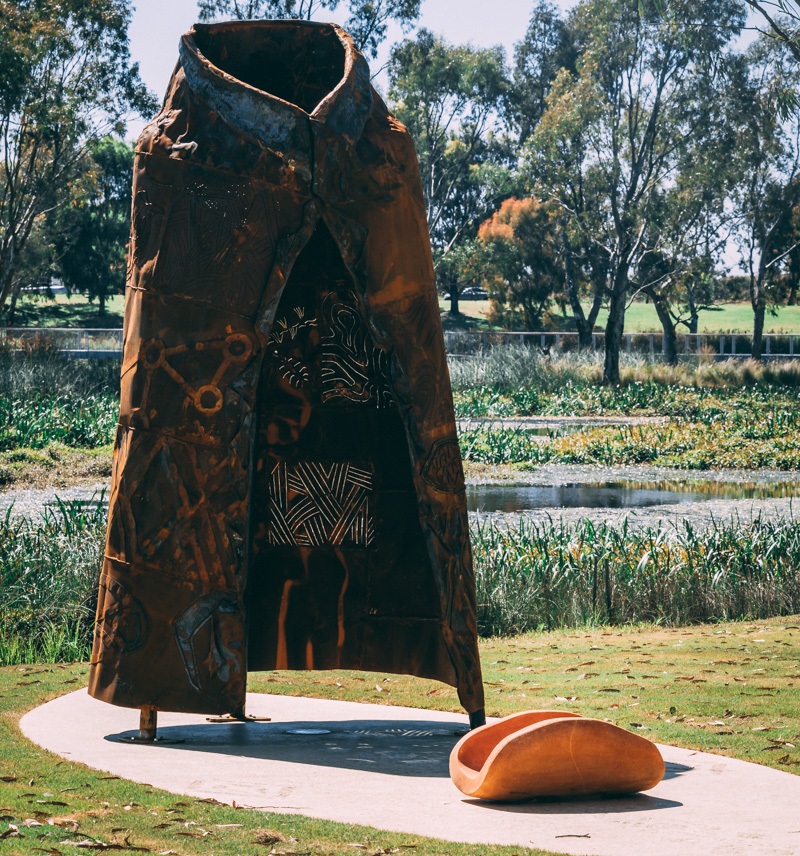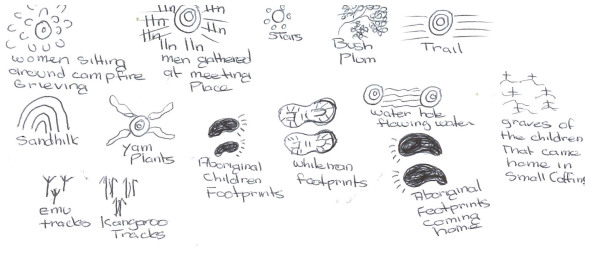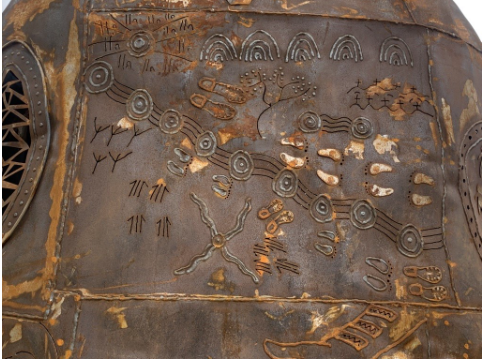Hume Stolen Generations Marker project

(Malcolm Creek Wetlands)
Council's commitment
Council has collaborated with Aboriginal and Torres Strait Islander communities to develop and install a permanent Stolen Generations Marker in Hume.
The project honours an important commitment made in Hume City Council’s Reconciliation Action Plan 2020-2022.
Located at the Malcolm Creek Wetlands in Craigieburn, the Marker pays tribute to the Stolen Generations – Aboriginal and Torres Strait Islander children who were forcibly removed from their families and communities - denied their identity, family, traditional culture and country through the race-based policies of State and Federal Governments between 1910 and the 1970s.
The site acknowledges the harm caused to Aboriginal and Torres Strait Islander children, families and communities across the nation, and serves as a reminder of terrible injustices caused by successive governments and their ongoing impacts.
Hume City Council is committed to recognising the lived experience of Aboriginal and Torres Strait Islander people and has created a permanent Marker to provide a place for Stolen Generations survivors, and their families, to gather and reflect.
The site provides an opportunity for all Australians to better understand and acknowledge the historical wrongs and help our communities to find a sense of peace, identity and belonging.
Making the Marker
In early 2020 Hume City Council established a Working Group to guide the Stolen Generation Marker project. The group included Aboriginal and Torres Strait Islander community members, community members with direct experience of impacts on the Stolen Generations and representatives from peak bodies including Connecting Home and Link-Up Victoria.
Following a careful concept development phase, overseen by the Stolen Generations Marker Working Group, Council engaged Gunnai/Waradjurie/Yorta Yorta/Gunditjmarra artist, Robert Young, to create the Marker for Hume.
Robert's installation, Covered in our Creator, features a large metal possum skin cloak (representing family), located on a canoe shaped ground artwork (representing journey) in front of a traditional coolamon rendered in stone (representing childhood).
The artist invited several Aboriginal and Torres Strait Islander community members with personal experiences related to the Stolen Generations to create original designs that feature on the surface of the large metal cloak. These community design contributions are unique in themselves and were made by the following people:
This artwork tells the story of the Stolen Generation, how Aboriginal children were forcibly taken from their parents. Taken to Domestic Training Schools to be trained as servants. Their mothers wouls sit around campfires greiving for their children.while the men gathered together in their meeting place to discuss their children who had been taken.
Some children were taken away by Police in vehicles, while others walked long distances accassionally stopping at waterholes to rest and would eat bush plums and other native foods known to them. The black footprints of the children, the large white footprints of the whiteman leading them away. The larger black footprints coming the opposite direction are those of the children now grown, coming home. Sadly a lot of children were brought home in small coffins, still affects a lot of Aboriginal families across Australia to this day.
My Grandmother Margaret Tucker M,B,E ( tribal name Lilardia) was one of the stolen generation forcibly removed from her mother at the age of 13 yo School to be trained as a Domestic Servant, nan was freed from this servitude at the age of 18yo and reconnected with her people. Nan (Margaret Tucker M.B.E) was awarded with the Member of the British Empire medal 1968 for the outstanding work she had donefor her beliefs to reconnect human kind. In nan's biography titled " If Everyone Cared" she tells the life stories which detailed the difficulties of Aboriginal people of the 20th century.My Grandmother had one Child, Mollie Dyer A.M
Mollie Dyer ( our mother) was an Aboriginal Child Welfare Worker and Aboriginal Community Worker. Mollie co-founded the Victorian Aboriginal Child Care Agency in 1977. Mollie Aboriginal leader, mother of 6 and foster mother to 19 ,devoted her career to caring fo Aboriginal Children. Mollie was recognised with a member of the Order Of Australia medal in 1979. Mollie successfully fought for the rights of all Aboriginal children to engage with their heritage and culture. Mollie also has a biography called " Room for one more".



Understand us and stand by us – by hands of connection, culture, country and dreaming, a journey of children and families, culture of proud Aboriginal people. Hands of time we embrace connect here and join in generations our connections, spiritual journey to connect and walk together in the rebirth of connectedness on country an Aboriginal land.
Strengths in positive parenting through pride, Identity, beliefs and learning of customs and cultural practices handed down by our elders and broader community is empowerment.
Knowledge shared through Elders, children and families prevents barriers of past practices and policies of Colonisation to be removed from our future generations. This disengagement of families to hold hands over generations
Reconnecting in our mother spirit and mother earth to nurture our next generation so they become strong in the hands of time.
My family and many families were not given access to connections to nurturing cultural knowledge. My great Grandmother Minnie Sullivan who met Grandfather Bloomfield a non-Aboriginal man, married in Tibooburra NSW where marriage rules for Aboriginal and non-Aboriginal were more relaxed.
in 1901 permission by the Protector of Native Affairs Fredrick Cornthwaite who consented for Gran to marry. At this point in time the Bloomfield clan began on journey through NSW as Grandfather was working in different towns in and around NSW.
1920, the family was moved to Griffith where Grandfather secured work in the Quarry to then finally secure work at Cooba where the family moved into a house in Darlington Point on the river on Wiradjuri country. This is where they remained until they passed away. Whilst my family never lived on Warangesda they suffered discrimination of being Aboriginal. The children could not attend school as it is known due to being Aboriginal. When a non-Aboriginal man with a disability fought to get the Aboriginal children access to attend school in 1926-1927. This is known as my grandfather remembered his brother Bill never attended school and spent all day under the building instead which says a lot about this era and the impacts on a proud child who still did not feel welcome inside the building.
I chose through my proud Matriarch and four generations to my son to be displayed as four hands of four generations of connections, culture, and land. Empowering as an honour of our families Matriarch my Great Grandmother Minnie Sullivan- Bloomfield.
We will honour our Matriarchs who remained strong and resilient to create a legacy of culture and family to which I belong. Embracing connection as we have and continue to do by holding our hands and hearts. The importance of stories and culture and spiritual connection to the country of our people and family. This honour is acknowledgment to the story of my Great Grandmother, her son, my son and my son’s daughter This has forged a legacy of strength she left with me in the generations and connections that are here to remain beyond the hands of time.
We the descendants of the Bloomfield family continue to gather and have reunions in Darlington Point, NSW every two years on the Easter Weekend to maintain this strength and resilience of a proud family and people. This offers us as a family opportunity to keep brothers’ sisters and many cousins and our elders connected and reconnect with those that we have not met and newborn children.
Furthermore I personally have been involved Program Manager in 2003 of Link Up Victoria the deputy chairperson Sorry Day committee of Victoria over many years and had been part of the National Executive of the Stolen Generations Alliance which was the change agents in the movement and lobbying the Federal Government for the National Apology and Reparations, I have been part of the records taskforce in Victoria was on the working group for the Darebin Council Stolen Generations marker project. These were the strengths I bring to this project within Hume as a resident for well over thirty years volunteering as part of the local Reconciliation action group at Hume Council. This project is another link in the journey of the pathway I followed in support to all Stolen Generations people In Victoria and wider Australia.


Project launch
The Marker formally opened to the public on 10 December 2022 and is an important new cultural site for Hume and Victoria.
Council will continue to introduce the general community to the site and build knowledge about the Stolen Generations, as part of broader work towards truth telling and reconciliation.
Reflections
As part of the Council's commitment to truth-telling and working towards healing and reparative futures, a video was commissioned on the anniversary of the National Apology. The video captures reflections from Survivors, their families, and the broader community on the significance of the Stolen Generations Marker.
In 2024, the Hume Stolen Generations Marker received the Maggolee Award from Reconciliation Victoria, acknowledging Hume City Council’s dedication to partnering with First Peoples to support self-determination, advance reconciliation, and amplify First Peoples' voices.
Want to be in touch?
If you would like to share stories, suggestions or feedback please contact artsandculture@hume.vic.gov.au.